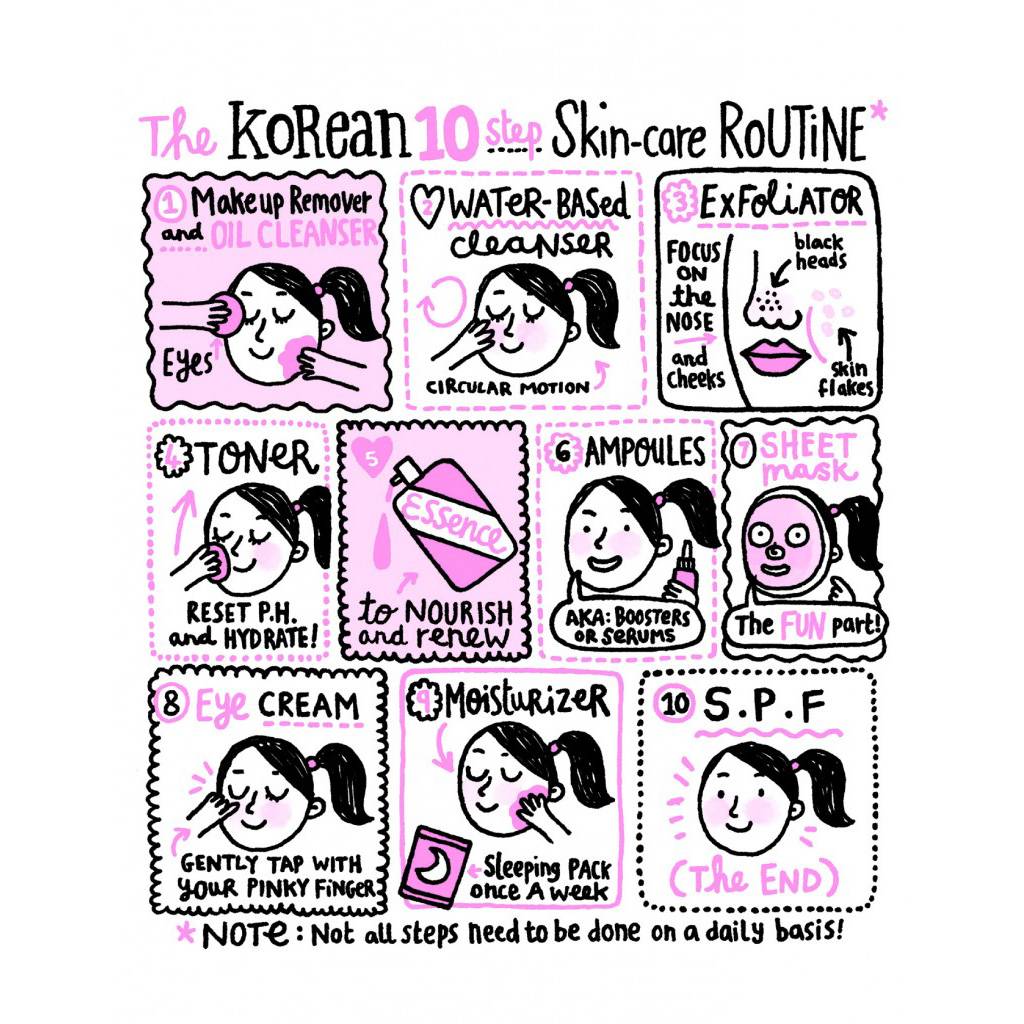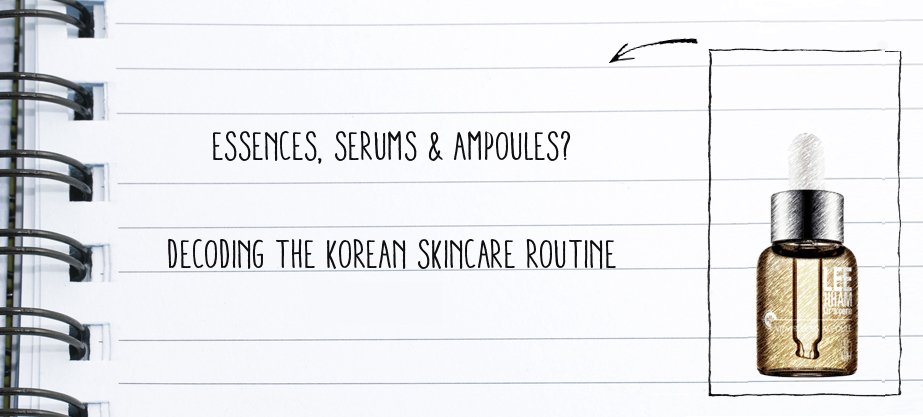All Korean Skincare Steps explained

Image Credit: Charlotte Cho's Little Book of Skincare.
Skincare is the soul of Korean beauty, that is why the average Korean skincare consists of 10 steps. The infamous 10-step Korean skincare routine may seem somewhat over the top to Western women, but it actually takes less time than you may think. Also, you don’t have to do all 10 steps every day of the week. Here at Little Wonderland we get a lot of questions about skincare steps. What are essences? What is the difference between a serum and an ampoule? Should I apply moisturizer after a sheet mask? We know a 10-step skincare routine can be overwhelming and confusing, that’s why today we’re going to debunk each step. We’re going to discuss what the purpose of each step is, give you some extra tips on how to use certain products, and try to demystify Korean skincare.
Cleansing
 | In the morning The first logical step in the morning would be to cleanse your skin. But is this really necessary? The truth is, there’s really no reason to cleanse your skin in the morning. It’s a matter of personal preference. If you’re oily like me, and turn into a grease ball by 12 pm, you’d probably like to cleanse your skin in the morning. But if you feel like your skin is fine, it doesn’t look dirty, and you wouldn’t mind leaving your skin as it is, you can totally skip this step in the morning. But if you do like to cleanse your skin in the morning, just make sure you’re using gentle cleansers. You don’t want to be overstripping your skin with harsh, drying cleanser. You can even use a cotton pad with a little bit of micellar water and simply wipe across your face as your morning cleanse. |
In the evening
Unlike in the morning, cleansing is vital in the evening. Your skin is covered in dirt and all kinds of pollutants from the day, and you’ve probably got some makeup on. The gentlest yet most effective way to cleanse your skin at night is to use a technique called ‘double cleansing’. Double cleansing is a two-step cleansing routine that includes two types of cleansers: an oil-based cleanser to remove base products in the first step, and a water-soluble cleanser to cleanse the skin in the second. Double cleansing is a clever way to get your skin super clean in a very gentle way. It's a huge perk of Korean skincare. We’ve actually written a blogpost on this concept. For more detailed information on double cleansing, click here.
Toner
| Back in the day when cleansers and soaps were harsher and used to throw off the skin’s pH to unhealthy levels, toners were developed to bring the skin’s pH back to normal. Over time cleansers got more sophisticated and gentler. Rebalancing the skin’s pH is not the main purpose of toners anymore. The main focus of toners now is to prep the skin for the next steps of your Korean skincare routine. Toners make your skin absorb more active ingredients from the serums and moisturizers you apply to your skin afterward. Besides that, a good toner is also loaded with antioxidants and skin-restoring and skin-replenishing ingredients that nourish your skin (e.g. vitamin C, AHAs and BHAs, Niacinamide). Nowadays toners are more diverse than ever. There are toners for every skin issue, from brightening toners, to hydrating toners, to toners that shrink enlarged pores. Look for toners that address your specific skincare issues. |  |

Treatments: Serums/Essences/Ampoules
This is where it gets a bit tricky and maybe confusing. Each of the products in this category are designed to deliver active ingredients deep into the dermis to address certain skin issues, like brightening dark spots, anti-aging, etc. So what is the difference, and do you need to use one of each?
Let’s start with the most well-known to Western women, serums. Serums are advanced, concentrated treatments designed to address specific skin needs in a focused, enriching manner. Serums are treatments, they do not need to contain sunscreens like daytime moisturizers, or emollients like nighttime moisturizers. Instead, serums use that space to pack in more concentrated active ingredients, like antioxidants, skin-replenishing, and skin-restoring ingredients to effectively treat a specific skin concern.
So then what are essences? Essences used to be a more lightweight, less concentrated version of serums, but nowadays the line between essences and serums is completely blurred. There are lightweight serums on the market, and essences are getting more and more concentrated. In fact, ‘serum’ and ‘essence’ are nothing but marketing words now. Now that Asian and Western companies are all exporting and importing each other’s products, the terms ‘serum’ and ‘essence’ are interchangeable. Both serums and essences are used at the same treatment step to achieve similar results. Asian consumers tend to be more familiar with the term ‘essence’, while the Western consumer prefers the term ‘serum’.
Next are ampoules. Ampoules are super concentrated serums that can be used in periods when your skin really needs a boost. Ampoules are typically recommended to be used for a finite amount of time, meaning, use an ampoule everyday for a few weeks (usually 2 weeks) as a supercharged treatment in lieu of your regular essence or serum. After the couple of weeks you should stop and go back to using a regular essence or serum. Make sure you follow the instructions on the package.
Eye cream
 | Quick note on eye creams. Eye creams are basically moisturizers for under your eyes. Do you really need one or can you just use your regular moisturizer under your eyes? The skin around your eyes is extremely delicate, very sensitive, and much more prone to dryness than the rest of your face. Most moisturizers will be too irritating for the skin around your eyes. Eye creams on the other hand, are specially formulated for the skin around the eyes; they’re much milder, they’re less irritating, and are free of fragrances. Besides that, eye creams also contain ingredients aimed at the problems we see around the eyes, like darkness, and puffiness. These are typically not seen in regular moisturizers. |
Moisturizer/Emulsion
Moisturizers have 1 primary goal: keeping moisture locked in. Moisturizers contain 3 basic ingredients:
|  |
Sunscreens
| Sunscreen should always be the last step of your (daytime) skincare routine. We all know the damage sunlight does to our skin. It is the #1 cause of premature aging and you can never start too soon with using sunscreen. Make sure you use a broad spectrum (protection against UVA and UVB) sunscreen with an SPF of at least 30, suitable for your skin type, and loaded with antioxidants. Apply sunscreens 15-30 min before you go outside. |

Sheet masks
Sheet masks are another brilliant Korean skincare invention. Sheet masks are literally ‘sheets’ that are soaked in an essence full of skin beneficial ingredients, such as vitamins, antioxidants, hyaluronic acid, ceramides, etc. You leave them on for 15-30 minutes, and then remove the sheet and pat the remaining essence into your skin. They’re like convenient facials for at home. Use a sheet mask 1-2x a week after cleansing and toning, before moisturizing to enhance your skincare routine.
Exfoliants
 | Dead skin cells can build up on our skin and congest our skin and clog our pores, leading to breakouts and dull skin. We can help our skin remove the buildup of dead cells and reveal the beautiful, soft, hydrated skin that hides underneath with exfoliants. There are 2 types of exfoliants: physical and chemical exfoliants. |
- Physical exfoliants exfoliate the skin with the use of small grains or ground up nuts. By rubbing the material against your skin, you can buff away dead skin cells, and reveal new skin.
- Chemical exfoliants exfoliate the skin by using a group of chemicals called Hydroxy Acids. AHAs (Alpha Hydroxy Acids) and BHAs (Beta Hydroxy Acids) remove the ‘glue’ that holds dead skin cells together. Once the bonds are broken, the skin naturally sheds, and you’ll be able to see the bright, youthful skin that has been hiding beneath. We also have a blogpost on chemical exfoliants and which ones to use. For more info, click here.
Exfoliating at least twice a week can really make a difference in how your skin and complexion looks. Not only does it reveal new skin, but it also helps your other skincare products absorb better.
So these are all the skincare steps and categories that are included in the typical Korean skincare routine. If you have any questions, don't hesitate to comment. Tune in next week for more skincare tips and tricks!








 Trending
Trending
 LW Blog
LW Blog












